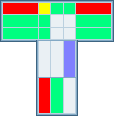Scanning
The most commonly used technique to find Hidden Singles in a Sudoku is scanning, although not everybody may know it by this name, or even realize that it has a name.
When we look at a floor, as depictured here, we can see that it is made up of 3 rows and 3 boxes.
For scanning purposes, we forget about the columns, so a floor can be depicted in a simplified way.
Now when we look at a single digit, the floor requires exactly 3 placements of it.
As shown here, these 3 digits can only be placed in 6 different ways in the simplified floor.
This really simplifies the way we can look at candidates within a floor. With 1 digit placed within the floor, only 2 configurations remain. With 2 digits placed, the boxrow containing the last digit is known.
To determine the correct minirow for a digit, you can use more information than just the other 2 placements of that digit within the floor. When all 3 cells in a minirow are either filled with another digit or eliminated by another placement of the digit in the column (see: Cross-Hatching), the complete boxrow is unavailable. A single unavailable boxrow leaves only 4 choices for the floor. In combination with a placed digit, the complete floor configuration for that digit is known. 2 unavailable boxrows in the same row or box leaves only 2 configurations.
The image here shows these situations with unavailable boxrows (red), known placements (blue) and available boxrows (green).
With the possible digit configuration in a floor known, we can focus our attention on those boxrows that are the only one available in their box. For these boxes, we will perform a similar scanning action on the intersecting tower. The very colorful picture on the right shows you the result. By analyzing the floor and the intersecting tower, the location of a digit has been determined.
Though this looks a little complicated with all the colors, it is something you can do from memory, because you do not have to remember so many pieces of information. There are, after all, only 6 permutations of the boxrows within a floor.
Side Effects
When you perform your scanning this way, you can skip the part of this Sudopedia that explains Locked Candidates. They are already taken into account when you consistently follow this scanning method.
Scanning has the same results as Cross-Hatching, but it is more methodical.


